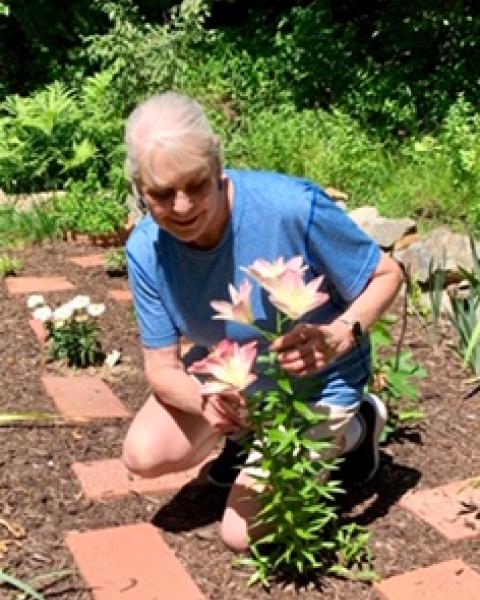Susan Strickler, A Boon for Canterbury

As a Canterbury Shaker Village (CSV) trustee, Susan Strickler enrolled in Master Gardener (MG) classes in spring 2021 “thinking she would be better prepared to work in her home gardens,” and the historic CSV gardens. Classes were held online due to COVID-19, and later outside at Massabesic Audubon Center in Auburn. That fall, Natural Resource Stewards (NRS) classes were held at the Shaker Village and she took those classes too. “I realized it would be a great boon to me, volunteering at CSV…and was delighted to join the NRS class.”
Canterbury Shaker Village, established in 1792, is a National Historic Landmark and Museum. It includes 29 well-preserved buildings surrounded by 694 acres; an enviable collection of Shaker objects, manuscripts, and photographs; and offers tours, hiking trails, exhibits and events.
In the summer between the two courses, Susan worked in the Village herb garden. “It needed attention,” she says, “and I was pretty much alone” taming weeds and observing what was coming up. Three years later, with “dedicated MG and NRS volunteers helping – especially Nancy Volpe and Jenn Solms who co-lead with me – the herb garden is thriving.” Volunteers have added herbs to the varieties that the Shakers either foraged or cultivated. Selling herbs, agricultural products, food, and wares was a source of revenue for the Shakers.
Susan served as Executive Director of the Currier Museum of Art in Manchester for 20 years, retiring in 2016. Since then, she has kept in touch with the museum. In 2020 she was asked by Maine’s Monhegan Museum to curate paintings by Maud Briggs Knowlton, who, in October 1929, became the Currier’s first director. Knowlton summered and painted on Monhegan Island from the 1890s to the 1950s. After the Monhegan show, the exhibit moved to the Currier.
Three years ago, Susan headed the grounds committee at the CSV. She helped with other volunteers to clear invasive plants from stone walls and foundations, prune Shaker-planted lilacs, and roses, and with a “major undertaking” restoring the historic apple orchard. She has led an effort to assess the health of iconic maples trees planted in 1859-1860. “These majestic trees are now more than 160 years old,” she says. The maples have grown without much attention. A tree specialist was hired to assess their condition. For their age, these monumental maples are in good shape and needed just a bit of pruning, cabling, and a root treatment.
“MG and NRS programs have given me a good foundation to work on these projects,” at Canterbury, she says, “and along the way I’ve been privileged to get to know some wonderful people.” There is “something so special about [the Village], the beauty of its landscape and simplicity of its architecture as I drive up Shaker Road each week. These assets…tell the story of interesting people who lived communally over the course of 200 years.”
Master Gardeners and Natural Resources Stewards such as Susan help to keep the Shaker history and legacy alive for visitors from throughout the US and the world.
